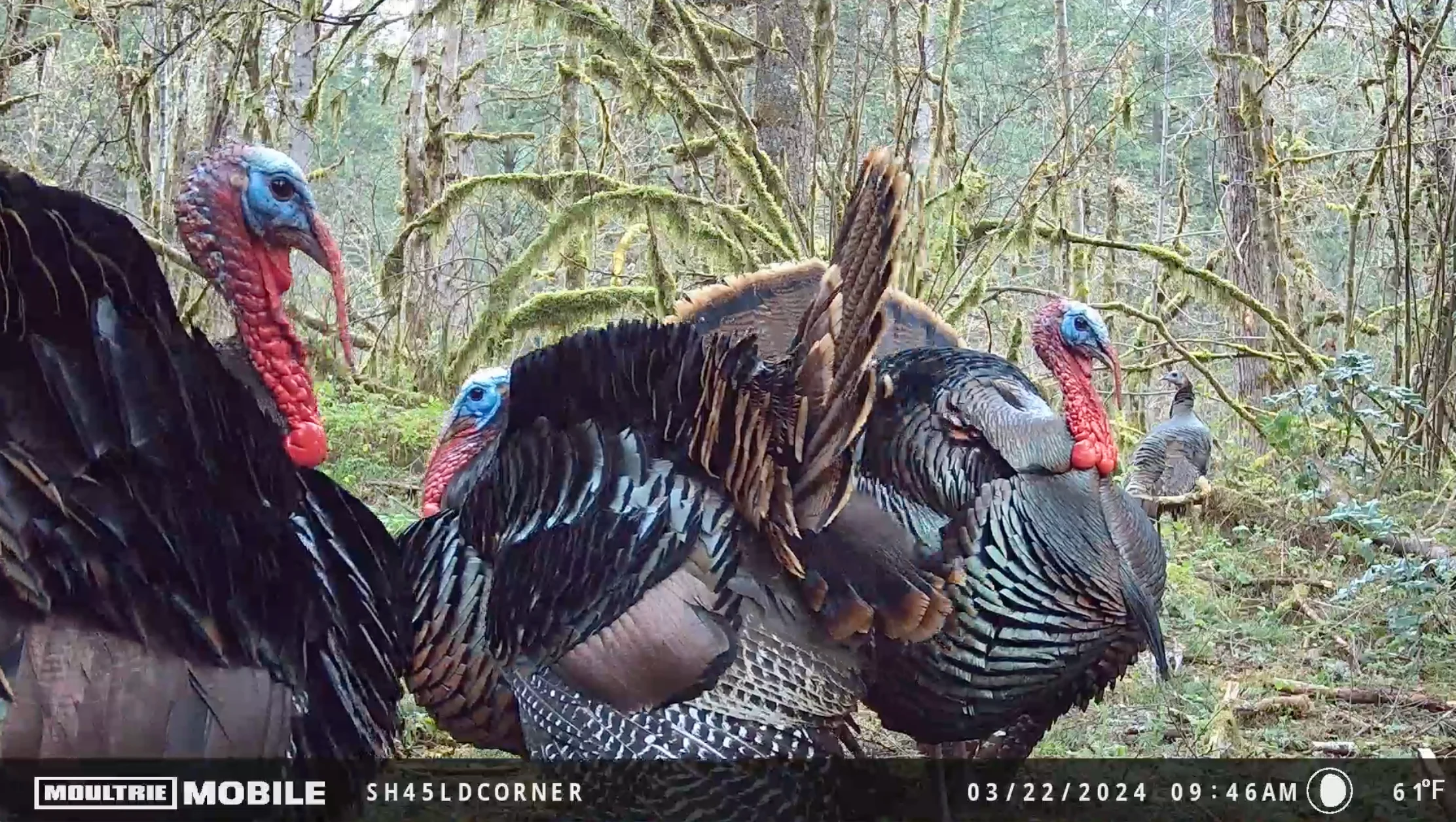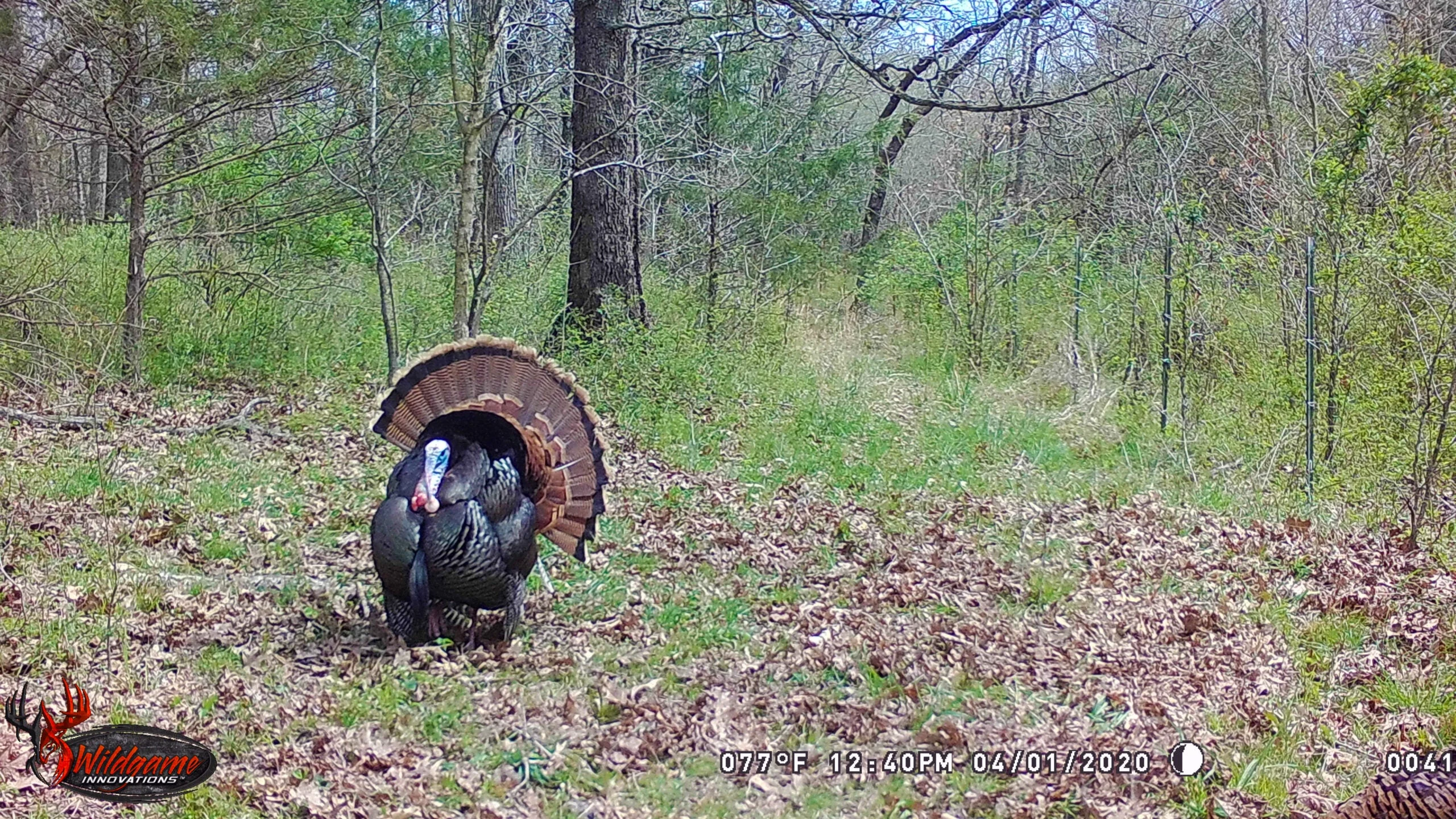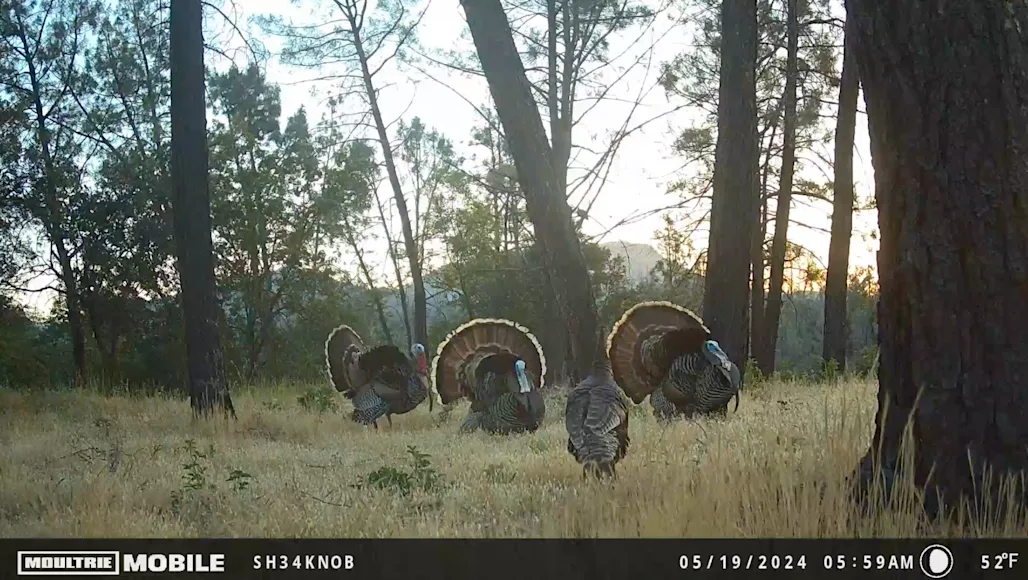We may earn revenue from the products available on this page and participate in affiliate programs. Learn more ›
With turkey seasons open, or soon to open, you know you should be out there listening and scouting to stay on top of gobbler activity. But who has time to get as often as we should? That’s where your trail cameras come in. While many whitetail nuts live and die by the intel provided by trail cams, very few turkey addicts use them, and that’s a big mistake.
Turkeys can be highly predictable, especially at or near their favorite roosts and feeding sites, and gobblers will patiently wait in strutting areas where they’ve attracted hens before. Properly placed trail cams can reveal these turkey spots and help you pin down when individual toms are most active and how they behave—all of which can take your hunting to another level. Here are ten tips for scouting turkeys with trail cameras.

1. Set Trail Cams to Field Scan Mode
If you’re just learning a property or having trouble nailing down exactly how turkeys use an area, forget trying to capture up-close action at first. Instead, set your cameras to “field scan” or “time lapse” mode (most camera brands have this feature). Field scan simply takes a pic at a predetermined interval (which you can set), whether it detects game or not.
As the name implies, this allows you to scan an entire field rather than just the area covered by the camera’s motion sensor. You’ll get pics of a feeding flock, for example, at 50, 100, or 200 yards away. If you see birds repeating that behavior over multiple days, you can then move your camera closer to their path and refine your intel. —Scott Bestul
2. Use Video Mode
Many deer hunters are hesitant to use video mode for their trail cams for understandable reasons. Deer cams are often on the landscape for many weeks in cold weather, and shooting video can drain expensive batteries (not to mention eating up valuable space on an SD card). But since your turkey cams will be out for only a few weeks, and the temps will be (hopefully) warmer, going video makes perfect sense.
The problem with still pics is they capture only a snapshot of the action when triggered. For example, if a couple of hens are leading three strutters, you might only get pics of one or two toms. If they’re clumped together and rush by when the camera is still in recovery mode, you could miss them altogether. Video gets an entire 20- or 30-second clip, which captures much more, including how the gobblers act with each other. If there’s a dominant bird, he might show his stuff. Video also captures movement; if birds are moving in a certain direction, a half-minute of footage will give you a much better idea of not only where birds are heading, but where they’ve been. —SB
3. Set Your Cameras Low
Position trail cameras low to the ground, pointing down trails. I run most trail cameras less than two feet off the ground, with the majority being half that distance. This lets you capture up-close sights and sounds you might otherwise miss. Turkeys don't tend to be camera-shy, so you can get away with setting cams at their eye level.
As Bestul pointed out, using video mode is crucial when scouting turkeys on trail cams. However, most cellular trail cameras have limited video clip time options. Choose the longest one offered. Several non-cellular trail cameras can have extended run times, up to two minutes or more. Choose that option and run it on the highest definition possible. When bird numbers are high during hunting season, I often set a cellular and a non-cellular camera on the same tree. The cellular trail camera captures a brief clip, whereas a two-minute clip from the non-cell SD card can reveal valuable information that may immediately impact my hunting plans. —Scott Haugen

4. Monitor the Hens
As hens move to nest in early spring, some toms will follow. Other toms stay put. Some hens travel upwards of 15 miles from wintering grounds to nesting sites. They routinely nest in the same place each spring. Gauging hen movement is a great way to see and even predict what toms will do, and how to best hunt them.
When hens start showing up with poults, watch them closely on trail cameras. A cold, wet rain within a clutch's first 10 days of life is a leading cause of death to young birds. A single hen will draw a lot of attention from toms, and though she likely won’t need to breed in order to lay a second round of eggs, toms don’t know that. This is when the chances of calling in a tom increase. —SH
5. Place Trail Cams on Favorite Food Groups

Now that you know the field scan and video tricks, you need to know where to place your cameras. Start with food sources. Gobblers don’t care much about eating now, but the hens they are after do. If food isn’t present, they’re not going to waste their time in a given area, and that means you’ll have a hard time calling a gobbler to that spot.
Keeping up with what turkeys are eating can be a scramble because these birds eat just about anything. Rather than trying to chase the favorite food of the moment, set your cams up on three main staples of the turkey diet. Mast is always a safe bet, and while the nut drop from last fall is far in the rearview, turkeys are experts at cleaning up any remaining acorns and, to a lesser extent, hickory and beech nuts. Look for fresh scratchings and set up cams in video mode to learn when birds are visiting. Waste grain in any farm field is a huge draw for early spring turkeys, especially if those fields have been covered in deep snow all winter, and these are perfect spots to set a cam on field scan mode.
Finally, put cameras in field scan overlooking the season’s first green fields (alfalfa and clover), as turkeys are as hungry for green food now as any wildlife species. The added bonus of green fields is that they usually host the spring’s first insects, which are a huge turkey staple. —SB
6. Mark New Toms
Positioning trail cameras close to the ground allows you to study identifying characteristics of individual turkeys. This goes a long way in thoroughly understanding turkey numbers, survival rates, and the longevity of specific birds. It also allows you to identify new toms that move into an area.
Every spring, in nearly every place where I have trail cameras set, new toms start showing up in the final two weeks of the season. These can be lone toms aggressively searching for receptive hens, or it may be a younger tom that’s been displaced by a dominant tom, or a growing bachelor flock of bullies. Either way, both are valuable pieces of information that lead to timely hunting opportunities. —SH

7. Identify Roost Sites
The surest way to kill a gobbler off the roost is to know which direction he is going to head after flydown. If you already know the location of a good roosting site, a trail camera can tell you the rest. Focus on mature trees by species. Eastern turkeys near my home love to roost in mature red oaks, while Merriams I’ve hunted are attached to towering pines, and the Rios I chase seem to select huge cottonwoods. In hilly terrain, I’ve found that birds prefer roosting on a south- or east-facing slope; this allows them to wake up to the sun’s first warming rays, an important consideration on the often-cold temps of early spring. Regardless of species, birds almost always have an open area nearby they can pitch down to; this ensures that they won’t land in a spot where predators lurk. This is a good place to plant a camera and set it on video mode to catch the direction of travel. —SB
8. Mimic Decoy Sets To What You’re Seeing
Let what you see on trail cameras help dictate your decoy choices and where to set up. If hens are spending hours a day early in the season preening in the timber, go with a preening hen decoy. I’ve had excellent success the past two seasons using a Dave Smith Decoys Preening Hen. This season, I plan on running a pair of them, especially early in the season when it’s raining, fields are wet, and hens spend a large portion of their day preening in the coniferous forest and beneath big, leafy, deciduous trees along river bottoms.
If jake numbers are high, run a jake and hen decoy, in tandem. Should tom ratios be high, a strutting tom decoy can bring them in on the run. Late in the season, a cautious tom might respond best to an upright hen decoy, as any tom decoy could send it running in the opposite direction. Pay attention to what you see on your cameras and match it to the best of your ability in your decoy setup. —SH

9. Take a Tom’s Temperature with Trail Cam Pics
Now, if you’ve got your cameras in the right places, and on the right modes, you’re going to get lots of pictures and footage. And if you look at it closely, it will tell you more than just where turkeys are active. It will help you lure in your next tom.
How toms react to your calling isn’t always about their desire to find a hen. They all want to be with hens. The critical question is, how badly do they want to fight off other gobblers for the right to that honor? Gobbler groups establish a pecking order that can remain through late May. Your ability to identify and respond to that dominance hierarchy can be critical, and your camera’s pics and video will reveal that.
Many flocks have a boss bird that rarely gets challenged. Watch for a tom that struts no matter the situation, or seems to roam among other turkeys without ever being challenged. This is your bird to call to aggressively, or use a strutter deke, to lure into range. Another factor to consider is “buddy birds”—two to four gobblers or jakes of similar age and size who always seem to run together. These bachelor groups can intimidate even the most bad-ass tom on the block, and aggressive tactics can work well here, too. By the same token, there are gobblers, sometimes really big ones, who are shy, don’t like fighting, and rarely strut. If your cameras tell you that a certain bird sticks to himself, doesn’t strut much, and never mixes it up with other toms, you’ll want to finesse that tom instead of challenge him. —SB
10. Monitor Predators
Predators of both land and sky can greatly impact turkey numbers and their behavior throughout the spring season. Two springs ago, I monitored seven hens and their broods. By late May, only one hen had two chicks remaining. Hawks, ravens, and furry predators killed the rest.
Bobcats appeared to be killing a fair share at night, as evidenced by my trail camera footage. They’ll climb trees and pluck young chicks off the roost. I caught one bobcat hauling off an adult hen it presumably killed. Skunks, gray foxes, opossums, and raccoons regularly prey on turkey nests and poults.
Coyotes take their toll on turkeys, too, and because they actively hunt them in daylight, it can scatter birds and put them on edge. “If there’s a coyote around, it’ll shut down turkeys in my area for a day or two,” shares noted turkey guide Jody Smith in Western Oregon. “There’s no calling those toms in, so we move.” —SH


